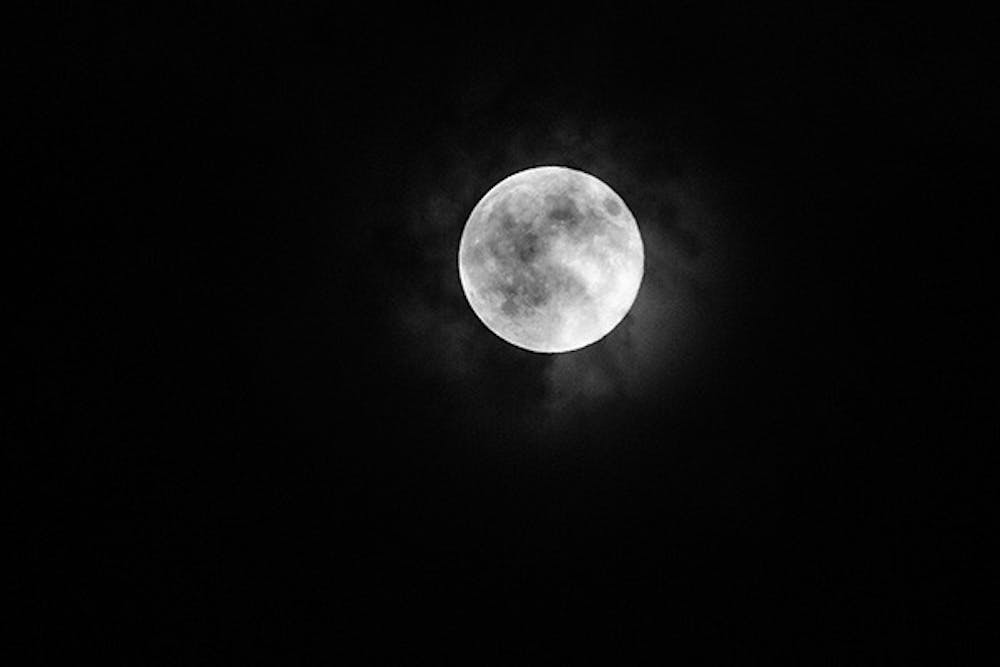 New research conducted by a group of ASU scientists suggests that the volcanic activity on the surface of the moon ended recently, not 1 billion years ago as commonly believed. (Photo by Ben Moffat)
New research conducted by a group of ASU scientists suggests that the volcanic activity on the surface of the moon ended recently, not 1 billion years ago as commonly believed. (Photo by Ben Moffat)
It is commonly believed that all volcanic activity on the surface of the moon ended more than 1 billion years ago, but new research conducted by a group of ASU scientists suggests that it may have ended much more recently.
ASU alumna Sarah Braden, who graduated from the School of Earth and Space Exploration in December with a doctorate in geological sciences, worked with other University scientists to author a research paper on lunar volcanism that was published on Oct. 12.
“It definitely changes the way we think about the moon,” she said. “Previous to our work, it was thought that the last evidence for volcanism on the lunar surface happened about a billion years ago, plus or minus 0.2 billion years. Our study is basically saying that there were small, isolated bursts of volcanism in many places that probably occurred much, much later than that.”
Braden and her colleagues used images collected by cameras attached to NASA’s Lunar Reconnaissance Orbiter to catalog a number of irregular patches in the moon’s basaltic flood plains, called the lunar maria, which led them to this conclusion.
The basis for the research lies in the fact that the moon’s lack of atmosphere has caused it to be impacted by millions of large meteors over the course of its existence, and each meteor leaves a visible crater on the lunar surface.
However, volcanic activity on the moon would have caused lava flows to essentially resurface stretches of land and obscure once visible craters with fresh basalt, and because of this lunar resurfacing, some areas of the moon’s surface are actually younger than others.
The younger areas of the lunar surface are identifiable by a smaller quantity of impact craters in photos taken by the LRO spacecraft, as they have simply not existed for a period of time long enough to collect a number of craters equal to the number of craters found on older surfaces.
Braden said the features of the impact craters in the younger areas are also visibly sharper than those of impact craters in older areas, suggesting they occurred more recently, but determining the age of these younger patches of the lunar maria based on the visual cues they provide is not as simple as it may seem.
“It’s one thing to look at something and say, ‘Oh, that looks young,’” she said. “It’s another thing to gather hundreds of measurements of craters and then do a whole analysis.”
Braden and her coworkers used datable samples of the lunar surface collected during the Apollo missions to calibrate the age of unexplored areas by comparing the crater landscape of the area from which the sample was collected to the crate landscapes of the areas in question.
She said the evidence they found suggested eruptions had occurred on the surface of the moon as late as about 50 million years ago — the blink of an eye on a geologic timescale.
Julie Stopar, a geological sciences doctoral student at SESE who worked with Braden on the research, said this discovery might cause people to rethink their interest in the moon.
“On the earth, we still have plate tectonics, and we still have volcanoes erupting, and so we know that there is still a lot of heat in the interior of the earth,” she said. “But the moon — when most people look at it they just see a gray surface covered by a lot of impact craters and nothing really new happening.”
Stopar said because evidence suggests the moon was volcanically active relatively recently, considering the magnitude of the geologic timescale, it makes it seem more “alive.”
Stopar said she enjoys conducting lunar research, and working to count the craters on unexplored parts of the moon to investigate the history of lunar volcanism was a great experience.
“I loved looking through the images because when you find one of those features, it’s this ‘aha’ moment,” she said. “You get really excited and you think, ‘Wow. I just found something that no one else has ever seen before.’"
SESE professor Samuel Lawrence, a planetary scientist who collaborated co-authored the lunar volcanism research, said he also enjoyed that aspect of the project.
“In planetary science, this is frontier science,” he said. “We’re exploring things no one’s ever looked at before — trying to discover things no one’s ever even thought of before. ... It is tremendously exciting to look at unexplored regions of another planet and make them explored.”
Lawrence said he looks forward to further investigation of the lunar maria, and he said he is interested to know if the results he and his fellow researchers obtained during their research will hold up to future scrutiny.
“It’s a profound, paradigm-shifting change,” he said of conclusions about lunar volcanic activity generated by his team’s research. “If (these patches in the lunar maria) are truly are as young as they appear to be based on our data set, it will definitely change what we know about the moon, and it will profoundly affect our understanding of the origin and evolution of the terrestrial planets.”
Reach the reporter at megannphillips@asu.edu or follow her on Twitter @megannphillips
Like The State Press on Facebook and follow @statepress on Twitter.




